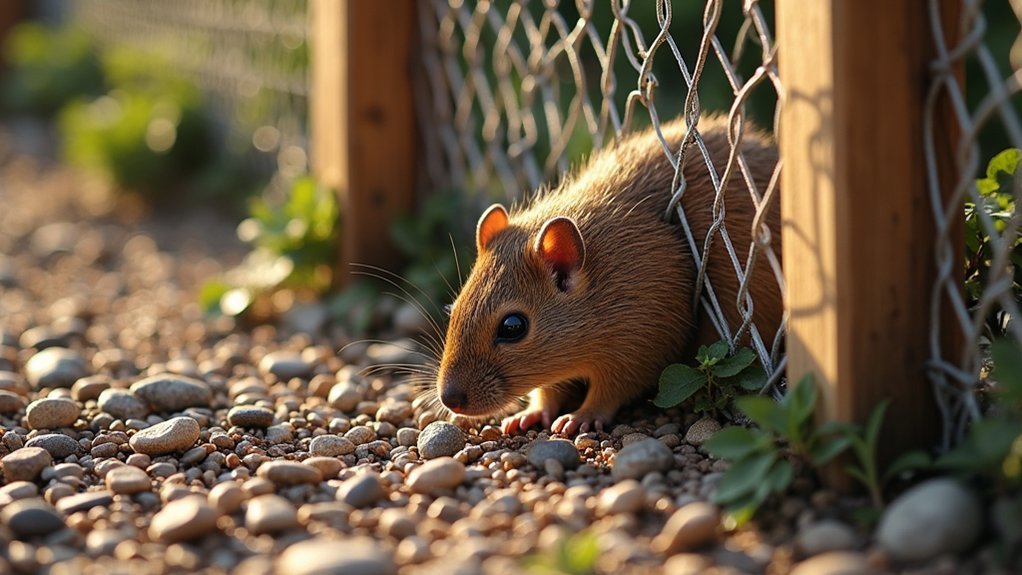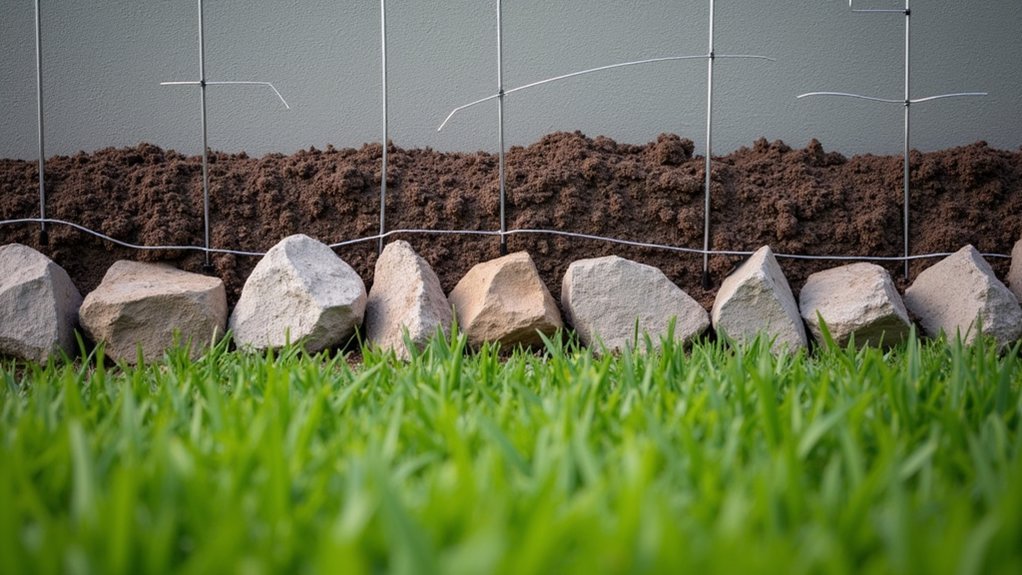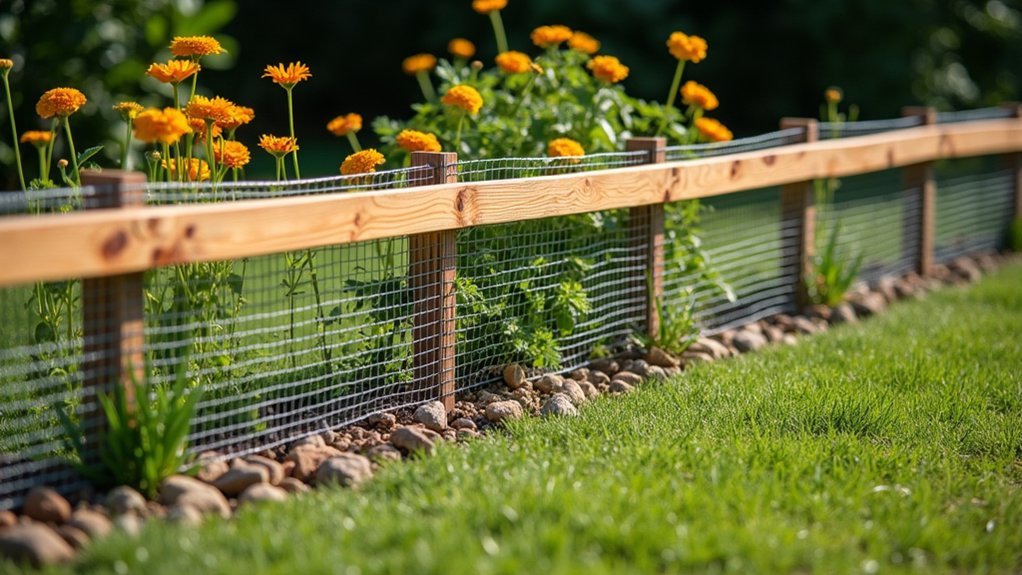Creating impenetrable outdoor rodent barriers requires understanding their capabilities first—mice can squeeze through 1/4-inch gaps and rats through 1/2-inch openings. Seal foundation cracks with concrete, install 1/4-inch hardware cloth over vents, and create a perimeter of compacted sharp gravel at least 18 inches deep. Plant deterrent herbs like mint and maintain a clutter-free yard. Monthly inspections are essential to spot and repair compromised areas. The complete system below will transform your property into a rodent-free zone.
Understanding Rodent Physical Capabilities and Vulnerabilities

Masters of infiltration, rodents possess remarkable physical abilities that make them challenging to exclude from properties. Mice can squeeze through openings as small as 1/4 inch, while rats need just over 1/2 inch to gain entry—making it essential to seal even tiny gaps to prevent rodents from infiltrating.
These persistent pests can climb vertical surfaces like concrete and wood, navigate along pipes and wires, and even jump impressively—rats can leap up to 36 inches vertically.
Nimble and resourceful, rodents scale walls, travel along utility lines, and jump astonishing heights with ease.
They’ll gnaw through wood, aluminum, and rubber with ease, requiring gnaw-resistant barriers like galvanized sheet metal for effective exclusion.
Despite these formidable skills, rodents have vulnerabilities. They avoid materials like copper mesh due to its antibacterial properties, making it an excellent choice for sealing potential rodent entry points.
Essential Materials for Effective Outdoor Barriers
When building defenses against rodent invaders, selecting the right materials makes all the difference between success and failure. Choose hardware cloth with 1/4-inch openings to cover vents and critical entry points in your rodent control strategy.
For gaps around pipes and conduits, use gnaw-resistant concrete or galvanized metal to thwart determined pests. Copper mesh offers superior protection due to its corrosion resistance and natural rodent-repelling properties.
| Material | Best Use | Protection Level |
|---|---|---|
| Hardware Cloth | Vents/Openings | Excellent |
| Copper Mesh | Small Gaps (2-3.8cm) | Superior |
| Galvanized Sheet Metal | Pipe Entryways | High |
| Aluminum Bands | Wall Barriers | Very Good |
| Compacted Gravel | Foundation Defense | Good |
Install aluminum sheet metal bands at least 36 inches high on walls to prevent climbing, and extend foundation barriers 36 inches underground to block burrowing rodents.
Securing Foundations and Ground-Level Entry Points

Securing your home against rodents starts with properly sealing foundation gaps using concrete or masonry grout to eliminate even the smallest entry points.
You’ll need to install a thick layer of compacted sharp gravel—at least 18 inches deep—under slabs and around the perimeter to create an effective burrowing deterrent.
Remember to extend foundation walls at least 36 inches below ground level to create a solid barrier that prevents determined rodents from tunneling their way inside.
Foundation Gap Sealing
The foundation of your home serves as the first line of defense against unwanted rodent invasions. To properly prevent rats and mice from entering, inspect your foundation for any gaps larger than 1/4 inch—mice can squeeze through these tiny openings, while rats need just over 1/2 inch.
Seal these vulnerabilities using concrete, galvanized sheet metal, or masonry grout. Foundation gap sealing should be thorough and systematic, paying special attention to utility entry points and corners.
For maximum protection, guarantee your foundation walls extend at least 36 inches below ground level, which deters burrowing and strengthens your barrier.
Maintain a clean, weed-free perimeter around your foundation to eliminate hiding spots. Consider adding concrete curtain walls or deep footings as additional protective measures against persistent rodent intrusions.
Gravel Barrier Installation
Three key elements make gravel barriers one of the most effective physical deterrents against rodent intrusion.
First, the sharp edges of compacted gravel create an uncomfortable surface that rodents avoid when burrowing. Install an 18-inch band of sharp gravel around your foundation, sloping it away to guarantee proper drainage.
Second, maintenance guarantees lasting protection. Keep the area surrounding your gravel barrier free of weeds and debris that could provide hiding spots for rodents. This cleanliness maximizes the barrier’s effectiveness in keeping rodents at bay.
Finally, regular inspection is vital. Check your gravel barrier periodically for signs of disturbance or erosion, and replenish as needed.
For peak protection, combine your gravel barrier with sealed foundation gaps and durable materials to create a thorough defense system.
Reinforcing Vents, Windows, and Exterior Openings
Since rodents can squeeze through surprisingly small openings, properly reinforcing your home’s exterior access points is essential for effective pest control.
Install galvanized hardware cloth or welded-wire mesh with holes no larger than 1/4 inch over vents and windows. For increased security, stuff stainless steel wool into cracks before sealing to prevent entry.
- Add crossbars to support screening on larger openings
- Seal clothes dryer vents with proper flaps or covers
- Check small-mesh screens regularly for dust or ice buildup
- Use stainless steel or copper mesh for durability
- Install mesh with secure fasteners that rodents can’t gnaw through
Remember to inspect your barriers regularly, as deteriorated screens or loosened attachments can quickly compromise your rodent defense system.
Creating Protective Zones With Strategic Landscaping

Properly designed landscaping serves as your first line of defense against persistent rodent invaders.
Create a natural barrier against rodents by planting aromatic herbs like mint, lavender, and rosemary around your property’s perimeter—these strong scents naturally repel unwanted visitors.
Incorporate sharp gravel or coarse mulch in your garden beds to make burrowing difficult for rodents seeking entry.
For additional protection, install raised garden beds with hardware cloth bottoms to prevent access to your precious plants while improving soil conditions.
Maintaining a clutter-free yard by regularly removing debris and food sources eliminates potential nesting sites that could lead to rodent infestation.
Remember that strategic landscaping isn’t just aesthetically pleasing—it’s a functional defense system that creates protective zones while enhancing your outdoor living space.
Installing Copper Mesh Barriers for Long-Term Protection
Copper mesh provides exceptional protection against persistent rodent invaders by creating an impenetrable barrier that blocks even the smallest entry points.
To effectively prevent rodents from accessing your property, cut the mesh to size and press it firmly into gaps, ensuring no space remains for mice or rats to squeeze through. This versatile material offers natural deterrent properties that rodents instinctively avoid.
- Cut copper mesh to fit openings as small as 2cm (mice) or 3.8cm (rats)
- Push mesh tightly into crevices, ensuring complete coverage with no gaps
- Leverage copper’s natural antibacterial properties that rodents avoid
- Enjoy long-lasting protection without frequent replacements due to corrosion resistance
- Combine with other prevention methods for thorough rodent control
Advanced Barrier Techniques for High-Risk Areas
While copper mesh works well for general prevention, areas with significant rodent pressure require more robust defense systems. For these high-risk zones, install galvanized hardware cloth or welded-wire mesh with openings no larger than 1/4 inch to effectively block even the smallest rodents.
Seal gaps around utility lines with concrete or galvanized sheet metal, ensuring all openings are smaller than 1/4 inch.
Install deep footings or concrete curtain walls extending at least 36 inches below ground to prevent burrowing rodents from accessing your foundation.
Don’t forget maintenance—regularly inspect and replace damaged barriers immediately.
Elevate outdoor storage on pallets and maintain a clean perimeter around structures to eliminate hiding spots.
These advanced techniques create a thorough defense system that will frustrate even the most determined rodents.
Monitoring and Maintaining Your Rodent Defense System
Establish a regular inspection schedule to check your outdoor barriers weekly for signs of wear, damage, or rodent tampering.
Maintain your defense system’s integrity by immediately repairing any compromised areas and reapplying sealants or repellents after heavy rainfall.
Track rodent activity patterns through droppings, gnaw marks, or disturbed barriers to identify vulnerable points in your protection strategy and make targeted improvements.
Regular Inspection Schedule
Maintaining a vigilant eye on your rodent barriers proves essential for long-term protection of your property. Establish a regular inspection schedule, performing thorough checks monthly to guarantee your defenses remain intact.
During these inspections, examine all potential entry points, looking specifically for gaps exceeding 1/4 inch for mice and 1/2 inch for rats.
- Check fence lines and wall foundations for signs of digging or gnawing
- Inspect weatherstripping and door sweeps for wear or damage
- Look for droppings, gnaw marks, and burrow holes that indicate active infestations
- Document all findings and repairs to track effectiveness over time
- Clear debris and food sources from your property’s perimeter
This systematic approach will greatly reduce the likelihood of rodent intrusions while maintaining your barrier system’s integrity throughout changing seasons.
Maintaining Barrier Integrity
Your rodent defense system requires consistent maintenance once installed to remain effective against persistent invaders. Conduct monthly inspections of all barriers—fences, mesh, and seals—to identify wear, damage, or potential entry points needing repair.
To prevent rodents, maintain a clean perimeter by removing debris and trimming overgrown vegetation that could provide cover or nesting opportunities.
Watch for droppings or gnaw marks around barriers to determine if adjustments are necessary.
Reapply protective coatings or sealants to copper mesh and galvanized hardware cloth as needed to guarantee lasting protection.
Keep detailed records of all inspections and maintenance work to track effectiveness and plan for timely repairs.
This proactive approach guarantees your barriers remain impenetrable year-round.
Track Activity Patterns
Vigilant monitoring complements your physical barriers by revealing when and how rodents attempt to breach your defenses.
By tracking activity patterns, you’ll gain valuable insights that help strengthen your protection strategy. Maintain a detailed log of all signs of rodent activity, including droppings, gnaw marks, and burrow locations to identify vulnerable areas requiring additional attention.
- Install monitoring stations at strategic locations to gauge rodent presence without attracting more pests
- Check for fresh droppings or new damage weekly, especially after weather changes
- Use non-toxic tracking powder near suspected entry points to reveal movement paths
- Take dated photos of potential problem areas to track changes over time
- Establish a monthly inspection routine that includes examining all barrier components for integrity
Frequently Asked Questions
What Material Can Mice Not Chew Through?
Mice can’t chew through steel, concrete, heavy-gauge aluminum, stainless steel mesh, copper mesh, or galvanized sheet metal. These materials are harder than their teeth, making them effective barriers for your rodent-proofing efforts.
What Is the Best Rodent Barrier?
The best rodent barrier you’ll find is galvanized sheet metal, concrete, or copper mesh. You can’t go wrong with copper mesh since it resists corrosion and naturally repels rodents while sealing gaps effectively.
Can Rodents Eat Through Copper Mesh?
No, rodents can’t eat through copper mesh. You’ll find they’re deterred by its antibacterial properties and unpleasant taste. The mesh’s tight weave and durability make it an effective barrier against their gnawing attempts.
How to Rat Proof Your House From Outside?
To rat-proof your house from outside, you’ll need to seal all gaps larger than 1/2 inch, install hardware cloth over vents, guarantee tight-fitting doors, extend foundation walls, and maintain a clean perimeter around your home.
In Summary
You’ve now gained the knowledge to build truly impenetrable rodent barriers around your property. By implementing these layered defense strategies, you’ll create an environment that’s hostile to pests but harmonious with your outdoor space. Remember, it’s the combination of physical barriers, strategic landscaping, and consistent maintenance that’ll keep your home rodent-free for years to come. Stay vigilant!





Leave a Reply